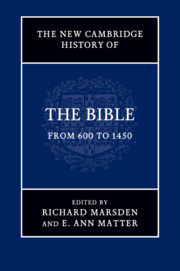Book contents
- Frontmatter
- Contents
- Figures
- Contributors
- Preface
- Abbreviations
- Abbreviations of books of the Bible
- Table of Psalm numbering
- Introduction
- Part I Texts and Versions
- 1 The Hebrew Bible
- 2 The Greek Christian Bible
- 3 Jewish Greek Bible versions
- 4 The Latin Bible, c. 600 to c. 900
- 5 The Latin Bible, c. 900 to the Council of Trent, 1546
- 6 The Bible in Ethiopic
- 7 The Bible in Arabic
- 8 The Bible in Armenian
- 9 The Bible in Georgian
- 10 The Bible in Slavonic
- 11 The Bible in Germanic
- 12 The Bible in English
- 13 The Bible in the languages of Scandinavia
- 14 The Bible in French
- 15 The Bible in Italian
- 16 The Bible in Spanish and Catalan
- Part II Format and Transmission
- Part III The Bible Interpreted
- Part IV The Bible in Use
- Part V The Bible Transformed
- Bibliography
- Index of biblical manuscripts
- Index of scriptural sources
- General index
- References
15 - The Bible in Italian
from Part I - Texts and Versions
Published online by Cambridge University Press: 28 May 2012
- Frontmatter
- Contents
- Figures
- Contributors
- Preface
- Abbreviations
- Abbreviations of books of the Bible
- Table of Psalm numbering
- Introduction
- Part I Texts and Versions
- 1 The Hebrew Bible
- 2 The Greek Christian Bible
- 3 Jewish Greek Bible versions
- 4 The Latin Bible, c. 600 to c. 900
- 5 The Latin Bible, c. 900 to the Council of Trent, 1546
- 6 The Bible in Ethiopic
- 7 The Bible in Arabic
- 8 The Bible in Armenian
- 9 The Bible in Georgian
- 10 The Bible in Slavonic
- 11 The Bible in Germanic
- 12 The Bible in English
- 13 The Bible in the languages of Scandinavia
- 14 The Bible in French
- 15 The Bible in Italian
- 16 The Bible in Spanish and Catalan
- Part II Format and Transmission
- Part III The Bible Interpreted
- Part IV The Bible in Use
- Part V The Bible Transformed
- Bibliography
- Index of biblical manuscripts
- Index of scriptural sources
- General index
- References
Summary
Introduction
To this day, establishing the medieval history of the Bible in Italian remains a complicated task. Only in recent years has there been systematic research on the manuscripts and, although the first critical editions have been produced, it is still not possible to draw up a fully coherent picture of the translation tradition. This tradition was born with the beginning of literature in the Italian vernaculars, and grew vigorously in the fourteenth century. It produced hundreds of witnesses in the fifteenth century, before generating an impressive printed output. The process went through numerous variations and revisions of the translated text but an underlying continuity persisted, so that for some books of the Old and New Testaments the first translation of the thirteenth or fourteenth century was copied and reused for some 200 years, until it became the basis of the earliest printed versions. The reconstruction of this process, however, can be only partial, and it still greatly depends on the direct study of the manuscripts.
The spread of scripture in the vernacular
The sacred text was the object of translation from the beginnings of written literature in Italian. In 1226, Francis of Assisi's Laudes creaturarum contained a paraphrase of several verses from Daniel, and in the same period a homily from Padua recorded pericopes from Matthew (manuscript PS60, still unpublished), while a version of the Pater noster was inserted in the Sermoni subalpini, perhaps as early as the twelfth century. The para-liturgical or homiletic context of these first occurrences was probably also that in which the first translations of complete biblical books were produced. But the circulation of the sacred text's vernacular version was far more widespread than this, as it was already the norm in the societas Christiana of medieval Europe.
- Type
- Chapter
- Information
- The New Cambridge History of the Bible , pp. 268 - 287Publisher: Cambridge University PressPrint publication year: 2012
References
- 1
- Cited by

